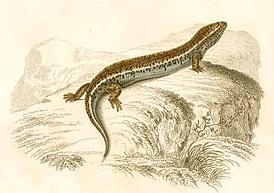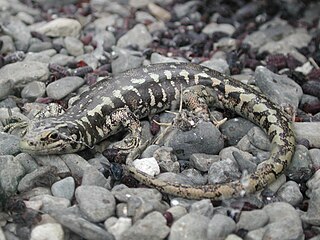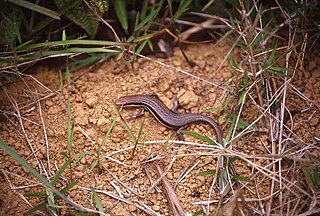
Brachymeles is a genus of skinks. Majority of the species within the genus are endemic to certain island ecosystems in the Philippines. In 2018, the Zoological Society of London through its EDGE of Existence Program listed the Cebu small worm skink as the 80th most evolutionarily distinct and globally endangered reptile species in the world, making it the most endangered member of the genus Brachymeles.

Carlia is a genus of skinks, commonly known as four-fingered skinks or rainbow skinks, in the subfamily Eugongylinae. Before being placed in this new subfamily, Carlia was recovered in a clade with the genera Niveoscincus, Lampropholis, and others of the Eugongylus group within Lygosominae.

Chalcides is a genus of skinks.

The earless skinks form the genus Hemiergis in the skink family Scincidae. All earless skinks are native to Australia.
Janetaescincus is a genus of burrowing skinks endemic to the Seychelles.

Lampropholis, the Indo-Australian ground skinks or sunskinks, are a genus of skinks in the lizard subfamily Eugongylinae. The genus Lampropholis was previously found to belong to a clade with the genera Niveoscincus, Leiolopisma and others of the Eugongylus group within Lygosominae. They are found mainly in Indonesia and Australia. For similar skinks see genera Bassiana, Pseudemoia, and Niveoscincus.

Chioninia coctei, also called the Cape Verde giant skink, Bibron's skink, lagarto, or Cocteau's skink, was a species of lizard, a reptile that was at one time known to inhabit the islets of Branco and Raso in the Cape Verde islands of the Atlantic Ocean, rendered deserts by human-caused habitat destruction. None have been observed since the early 20th century, and the species was officially declared extinct in 2013.

Oligosoma is a genus of small to medium-sized skinks found only in New Zealand as well as Norfolk and Lord Howe islands. Oligosoma had previously been found to belong to the Eugongylus group of genera in the subfamily Lygosominae; the Australian genus Bassiana appears to be fairly closely related.

Ophiomorus is a genus of Old World skinks.
Paracontias is a genus of skinks, lizards in the family Scincidae. The genus is endemic to Madagascar.
Pseudemoia is a genus of skinks native to southeastern Australia. For similar skinks see genera Bassiana, Lampropholis, and Niveoscincus.
Sepsina is a genus of skinks. The genus is endemic to southern Africa.

Tribolonotus is a genus of lizards, commonly known as crocodile skinks.
Tropidophorus is a genus of semiaquatic lizards in the skink family (Scincidae), found in Indochina, Borneo, Sulawesi, and the Philippines. They are sometimes known as water skinks or waterside skinks.

Ablepharus kitaibelii, commonly known as the European copper skink, European snake-eyed skink, juniper skink, or snake-eyed skink, is a species of skink, a lizard in the family Scincidae. The species is endemic to Eastern Europe and Southwestern Asia.

Trachylepis is a skink genus in the subfamily Lygosominae found mainly in Africa. Its members were formerly included in the "wastebin taxon" Mabuya, and for some time in Euprepis. As defined today, Trachylepis contains the clade of Afro-Malagasy mabuyas. The genus also contains a species from the Brazilian island of Fernando de Noronha, T. atlantica, and may occur in mainland South America with Trachylepis tschudii and Trachylepis maculata, both poorly known and enigmatic. The ancestors of T. atlantica are believed to have rafted across the Atlantic from Africa during the last 9 million years.

Scincinae is a subfamily of lizards. The subfamily contains 33 genera, and the genera contain a combined total of 284 species, commonly called skinks. The systematics is at times controversial. The group is probably paraphyletic. It is one of three subfamilies of the family Scincidae, the other two being Acontinae and Lygosominae.

Chioninia is a genus of skinks, lizards in the subfamily Lygosominae. For long, this genus was included in the "wastebin taxon" Mabuya. The genus Chioninia contains the Cape Verde mabuyas.

Brachymeles bonitae, commonly known as the stub-limbed burrowing skink or pretty short-legged skink, is a species of skink found in the Philippines. It was first described in 1839 by André Marie Constant Duméril and Gabriel Bibron. It is endemic to the Philippines.

Trachylepis gravenhorstii, also known commonly as Gravenhorst's mabuya, is a species of skink, a lizard in the family Scincidae. The species is endemic to Madagascar.















